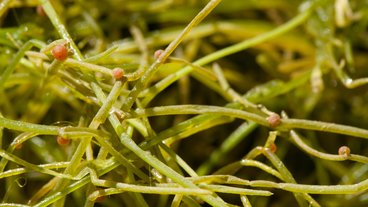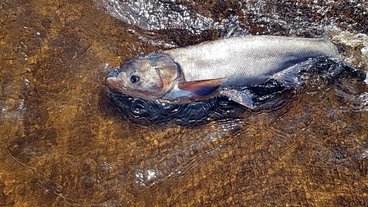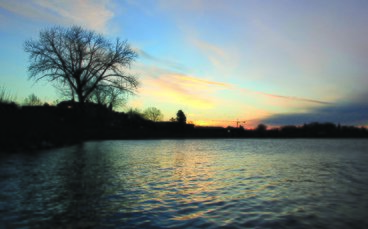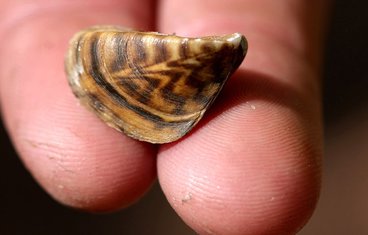
Starry Trek comes to Beltrami County: Volunteers needed for Aug. 5 event to help search for starry stonewort
Volunteers from across Minnesota are needed on Saturday, Aug. 5, to participate in a statewide search for starry stonewort, Minnesota’s newest aquatic invasive species, which has been found in several Bemidji-area lakes.
Hundreds of volunteers will gather at rendezvous sites statewide for Starry Trek, where they will learn how to identify starry stonewort and search for it in area lakes, according to a release from Bruce Anspach, Beltrami County’s Aquatic Invasive Species Lake Technician.
Starry stonewort is an invasive algae that was first found in Lake Koronis in 2015 and has since spread to nine Minnesota lakes, including, Upper Red Lake, Big Turtle Lake, Moose Lake and Cass Lake in Beltrami County and Lake Winnibigoshish in Itasca and Cass counties.

Minnesota scientists dive deep to learn why walleye are stressed
To understand what's happening to walleye populations, it turns out you need to do more than just count fish.
"Walleye in these large lakes are being affected by large scale stressors like invasive species, climate change, so to understand and manage the population we need to understand what they're eating, what's eating them and how that's changing," said Minnesota Department of Natural Resources research scientist Gretchen Hansen.
Nine of the state's largest lakes are part of a new study that aims to gain a deeper understanding of how life works under the waves.

Minnesota Researchers First to Try New Method to Kill Zebra Mussels
Researchers are hopeful they’ve found a new way to control zebra mussels in Minnesota's lakes and rivers.
Zebra mussels and other aquatic invasive species are a growing concern.
The Minnesota DNR reports 213 bodies of water are currently infested with zebra mussels.
But now, instead of using high-dose pesticides to kill adult zebra mussels in a small area, researchers are using a copper-based product in lower doses.

Invasive carp has quieted down, but 'Minnesotans should be concerned'
Angst surrounding invasive carp may have eased in parts of Minnesota, but behind-the-scenes work ramps up as the threat remains.
The first of the heavy-eating fish, originally known as Asian carp, was caught in Minnesota in 1991. At least one has been caught every year since 2006, with six so far this year. Scientists think they have just been individual fish, not part of a reproducing colony. No young fish have been caught.
The fear is that invasive carp will take over areas native fish need, eating their food and forcing them out.

Researchers test new method to control zebra mussel population on Lake Minnetonka
A new study continues on Lake Minnetonka in an effort to effectively manage zebra mussel populations.
Researchers from the Minnehaha Creek Watershed District and the Minnesota Aquatic Invasive Species Research Center are testing the use of a copper-based product to reduce the survival of zebra mussel larvae. By targeting the youngest zebra mussels, researchers hope the overall population can be decreased.
The study, funded by a $30,500 grant from Hennepin County, is the first known field test of its kind in the country.

Researchers continue testing new zebra mussel control method
A study is continuing in Lake Minnetonka this year on a potentially new method to effectively manage zebra mussel populations.
Researchers from the Minnehaha Creek Watershed District (MCWD) and the Minnesota Aquatic Invasive Species Research Center (MAISRC) are testing the use of a copper-based product to reduce the survival of zebra mussel veligers (larvae). By targeting the youngest zebra mussels, it’s hoped the overall zebra mussel population can be decreased. The study, funded by a $30,500 grant from Hennepin County, is the first known field test of its kind in the country.

Lake Minnetonka zebra mussel study tests population control
A study is continuing in Lake Minnetonka this year on a potential new method to control zebra mussel populations.
Researchers from the Minnehaha Creek Watershed District and the Minnesota Aquatic Invasive Species Research Center are testing low doses of a copper-based product to kill off or at least slow the spread of zebra mussel larvae, known as veligers.
By targeting the youngest zebra mussels, researchers hope the overall population can be decreased.
The study is funded by a $30,500 grant from Hennepin County. The watershed district says it's the first known field test of its kind in the country.
Minnesota lists over 200 water bodies as infested with zebra mussels since 1989. They were first detected in Lake Minnetonka, the largest lake in the Twin Cities area, in 2010.

Lake Minnetonka zebra mussel project continues
A study is continuing in Lake Minnetonka this year on a potential new method to control zebra mussel populations.
Researchers from the Minnehaha Creek Watershed District and the Minnesota Aquatic Invasive Species Research Center are testing low doses of a copper-based product to kill off or at least slow the spread of zebra mussel larvae, known as veligers.
By targeting the youngest zebra mussels, researchers hope the overall population can be decreased.
The study is funded by a $30,500 grant from Hennepin County. The watershed district says it's the first known field test of its kind in the country.

Reader Opinion: The fight against AIS
Minnesotans across the state are well aware of the threat posed to our way of life by aquatic invasive species. Our lake culture—especially in the Brainerd lakes area—is longstanding and held dearly by many. Although many challenges remain, I believe that there is much hope to be found in the work being done at the Minnesota Aquatic Invasive Species Research Center at the University of Minnesota.
Researchers at MAISRC are hard at work developing science-based solutions for the control of zebra mussels, spiny waterflea, starry stonewort, and many other species. We've already had some successes, and several groundbreaking projects are moving forward in exciting and promising directions. We also recently certified 125 new AIS Detectors—including dozens from the Brainerd area—who will be on the lookout for AIS.
Ongoing funding to support this work is critical to our success and we have four area legislators to thank for their assistance this past legislative session. We're pleased to thank Rep. Josh Heintzeman, R-Nisswa, for his work to shepherd $2.7 million of funding to MAISRC over four years from the Environment and Natural Resources Trust Fund.
Sen. Carrie Ruud, R-Breezy Point, and Rep. Dale Lueck, R-Aitkin, also played integral roles in securing $410,000 of recurring funding for MAISRC in the Environment bill. Sen. Paul Gazelka, R-Nisswa, also played a key role supporting these efforts.

UMN Training Aquatic Invader Detectors
A new group of volunteers trained to spot aquatic invasive species is branching out on Minnesota lakes to collect samples, take photos and report back to the Department of Natural Resources.
The more than a dozen volunteers are the latest graduates from the Aquatic Invasive Species program, Minnesota Public Radio reported. It's a joint project between the University of Minnesota Extension Service and the Aquatic Invasive Species Research Center.
It can take volunteers sometime to spot the minute differences, said Megan Weber, an educator at the university extension.
